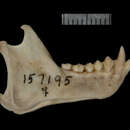Biology
provided by Arkive
The cotton-headed top tamarin is diurnal and arboreal, feeding on fruit, insects, tender vegetation, small vertebrates and bird eggs (6) (10). With the exception of smaller prey, animals are killed with a bite to the head (3). Cotton-headed tamarins obtain the water they need by licking leaves that are wet with rain or dew, rather than expose themselves to predation by venturing down onto the forest floor (5). When not feeding, much time is spent in social grooming. Like other tamarins, they run their clawed digits through each other's fur, examining it, and use their teeth, lips and tongue to pick off particles (8).
These social monkeys live in groups of 3 – 13 individuals, with the average being around 7 (2). Their home ranges extend from 7-10 hectares and often overlap with those of other groups, with contact between groups being agonistic (5). These tamarins are territorial, scent marking their home ranges and defending them with showy confrontations, fluffing up their fur and making loud calls to scare away intruders and attract individuals from their own group (6).
There can be more than one adult male and female in the group but only one female actually breeds (3) (5). Reproduction in other females is suppressed by the behavioural domination of the reproductive female, and by the effects of her pheromones and genital gland scent (6). Males and other group members play a major role in caring for the young (8). The co-operative breeding system of tamarins appears to be unique amongst primates, and serves to help the breeding female care for the offspring (7). Lactation and feeding the young demands a great deal of energy, and so males and other group members often carry the young, allowing the female more time to forage and feed, while other members of the group also help by surrendering food morsels to the young and the breeding female (7). This explains why the female is usually larger in size than the male. In fact, research suggests that smaller males are often preferred mating partners by the females as they are more nimble in the forest and therefore better food gatherers (6).
Like other tamarins, the cotton-headed tamarin usually gives birth to twins (8) (9). The gestation period is around 140 days (2), and the offspring, born helpless (3), are carried everywhere rather than being left in nests (9). The co-operative care of the group is key to the infant's development, for they become independent after only two months. This unique breeding system is also essential as it enables tamarins to maintain a high reproductive rate (6). Once established as breeders in a group, a female can produce twins once a year, and sometimes twice (9).
Conservation
provided by Arkive
The cotton-headed tamarin has been listed as endangered since 1970 by the International Union for Conservation of Nature and Natural Resources (IUCN) (1). It is also recognised as endangered on the USDI (3), and its listing under Appendix I of the Convention for International Trade of Endangered Species (CITES) means that international trade of this species is prohibited (3). However, its numbers have continued to dwindle away, as has its habitat and hope of survival. If this species is to survive, it is essential that immediate conservation measures are implemented (3) (8).
Description
provided by Arkive
The stunning cotton-headed tamarin is one of South America's most endangered primates (5). Its name describes the fantastic crest of long white hair flowing around the black face like a mane of white cotton (6). Its body is small and covered with thick fur, with a brown back and shoulders, and white to yellow chest and limbs (6). The fore and hind limbs are similar in size, allowing it to move quadrupedally through the forest, running along branches or jumping short distances between tree braches (7) (8). Like marmosets and other tamarins, the ancestral primate nails on their toes and fingers have evolved into claws on all but their big toes, allowing them to climb in a squirrel-like fashion in the trees (6) (9). This small monkey has a long tail, which assists in balance; it is reddish orange towards the base and black towards the tip (5). Males and females look the same in appearance, as do the young (7).
Habitat
provided by Arkive
This species is found in tropical rainforest edges and secondary forests. It has been found in a variety of habitats from wetland tropical forest, to moist woodland forest and dry thorn forest savannah (5).
Range
provided by Arkive
Confined to Colombia, but formerly much more widespread across the country (2).
Status
provided by Arkive
Classified as Endangered (EN B1 + 2abcde, C2a) on the IUCN Red List 2002 (1), listed as endangered by the USDI (3) and listed on Appendix 1 of CITES (4).
Threats
provided by Arkive
Deforestation is this species' greatest threat (6). It has already lost most of its habitat through forest clearing for timber, charcoal, human settlement, agricultural land and industry (3). The forest areas in which it now exists are so fragmented, it is believed that they are too small to maintain the tamarin populations (3). Sadly the continuous expansion of human settlement in northern Colombia has brought the cotton-headed top tamarin more bad luck. With easier access to the tamarin's habitat, animal collectors trap these small monkeys and sell them in port cities, either for export or local trade (10). Populations in the past have also suffered from the export of significant numbers for biomedical research in the 1960s and 1970s (5) (9).

